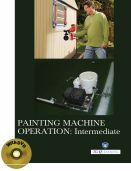Trade and Industrial Education

Painting Machine Operation: Intermediate deals with numerous diverse practical and visual skills with knowledge of specialized materials and techniques. Painting machine operators are responsible for applying a layer or layers or paint or coating to a product to protect it from the elements and/or make it more aesthetically appealing. Prepares surfaces, cleans, product, and applies coating. This book will introduce the knowledge and skills for those studying and/or working in painting machine industry.
About this Book
The information in this book consists of competencies that a person must achieve to perform pre-treatment and cathodic electro-deposition process operations; perform gray primer (2nd primer) application procedures; and perform top-coat application procedures in accordance with manufacturer’s specifications.
About the Painting and Coating Machine Industry
Millions of items ranging from cars to candy are covered by paint, plastic, varnish, chocolate, or some other type of coating solution. Often the protection provided by the paint or coating is essential to the product, as with the coating of insulating material covering wires and other electrical and electronic components. Many paints and coatings have dual purposes, such as the paint finish on an automobile, which heightens the visual appearance of the vehicle while providing protection from corrosion. Painting, coating, and spraying machine setters, operators, and tenders control the machinery that applies these paints and coatings to a wide range of manufactured products. Perhaps the most straightforward technique is simply dipping an item in a large vat of paint or other coating. This is the technique used by dippers, who immerse racks or baskets of articles in vats of paint, liquid plastic, or other solutions using a power hoist. Similarly, tumbling barrel painters deposit articles made of porous materials in a barrel of paint, varnish, or other coating, which is then rotated to insure thorough coverage. Workers in this field set up, tend, operate and inspect coating and plating machines and equipment. These machines coat metal or plastic objects with metals, glaze, varnish rubber or other materials to protect or decorate them. Completion of high school or its equivalent training is usually necessary to be considered for this position. Painting and coating workers held about 195,000 jobs in 2009. Lesser skilled coating, painting, and spraying machine setters, operators, and tenders accounted for about 108,000 jobs, while more skilled transportation equipment painters accounted for about 49,000. About 38,000 workers were painting, coating, and decorating workers. Seventy-one percent of jobs for salaried workers were found in manufacturing establishments, where they applied coatings to items such as fabricated metal products, motor vehicles and related equipment, industrial machines, household and office furniture, and plastics, wood, and paper products. Other workers included automotive painters employed by independent automotive repair shops and body repair and paint shops operated by retail motor vehicle dealers. About 7 percent of painting and coating machine operators were self-employed; most of these were transportation equipment painters.